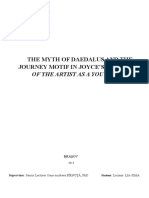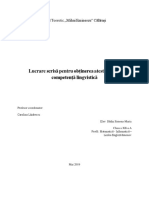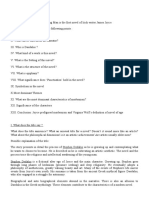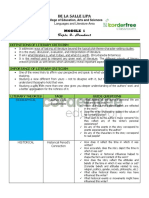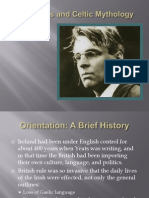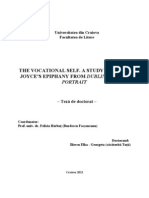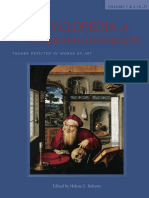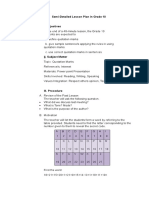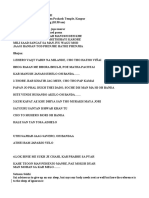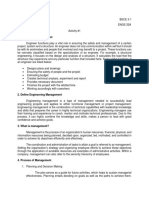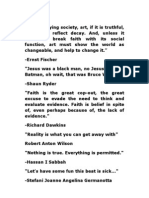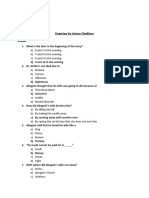PART I
The modern hero, the modern individual who dares to heed the call and seek the mansion
of that presence with whom it is our whole destiny to be atoned, cannot, indeed must not, wait
for his community to cast off its slough of pride, fear, rationalized avarice, and sanctified
misunderstanding. "Live," Nietzsche says, "as though the day were here." It is not society that is
to guide and save the creative hero, but precisely the reverse.
One constant force in human life is the search for identity. In a world, divided according to
similarities and differences among human beings, the sense of belonging becomes an important
element in the definition of one’s identity. Human beings have long tried to define their origins
and their place in the world; hence, they are in a constant search for a model to identify with and
follow in order to consolidate their self awareness and awareness of the word.
The reproduction of certain traits in the construction of one’s identity caught my attention
during the writing of my undergraduate work of course conclusion, in which I explored the
counterpart relations among Joyce’s characters in Dubliners.
From then on, I realized that those counterpart relations were not restricted only to the
characters in Dubliners, but also to the whole Joycean corpus.
Moreover, I was able to perceive that Joyce constructed those counterpart relations by
weaving intertextuality, imagination and factuality.
Thus, I adhered to that group of critics that did not give credence to the “death of the
author,” and decided to investigate Joyce’s life and his social context. Not surprisingly, Irish
culture and literature revealed themselves to be fascinating parts on the search and reconstruction
of an Irish identity during and after the long years under British domination.
Although some of the authors who emerged during the Irish Revival received and still
receive the attention of readers and critics, it is undeniable that James Joyce has earned a special
place in the western canon.
Besides being a new influence on the writings of other writers, his works have been an
endless source of material for critics and scholars.
�Joyce’s life has been explored almost with the same enthusiasm as his works due to the
biographical traces in his writings.
The author lived in a self-imposed exile from Ireland, and yet, in reading his works, we
observe that Ireland was never far from him. Ireland was his starting and finishing points, and the
mixture of the mythological and the commonplace was his main characteristic.
Much has been written about the mythological allusions in Joyce’s masterpiece Ulysses
and in his complex final work, Finnegan’s Wake, but his first novel, A Portrait of the Artist as a
Young Monteiro 3 Man, also suggests mythological aspects that have not been as deeply
explored by criticism, perhaps due to the success of his later novels.
The possession of special skills associated with the situation of being an outsider, the
“heroic Odyssey of apartness”, are just some of the features of the hero archetype that we can
find in the novel.
Perhaps because he wanted to make a myth of his own life and the artistic path he chose
for himself, Joyce seems to have projected upon Stephen Dedalus and his journey several
characteristic features of the classic hero and the hero’s journey.
One could say that, by sharing the features of a hero, the protagonist of Joyce’s first novel
elevates the condition of the artist to the role of savior, redeemer, and even saint. These several
masks of the “artist-hero” are the reflection of his attempts to bring consciousness to his people
and help their identity reconstruction.
Stephen is a character with many nuances worth being explored. Even though the novel
presents him with an aura of a mythic hero, it also shows his Monteiro 4 flaws and doubts,
bringing him closer to the average human being.
This fact contributed to the classification of the character as an antihero, i.e. someone who
does not fit the archetype of the hero, even though he has noble purposes and other heroic
features.
However, especially during the twentieth century, with the appearance of tormented or
unscrupulous heroes in fantasy literature, comic books, graphic novels, science fiction, and
literature in general, the concept of hero and its variants began to show some fluidity. Stephen’s
�flaws only contribute to bring him closer to his human side, instead of simply deviating him from
the heroic journey.
This thesis intends to investigate in what sense the journey of formation of an artist,
developed in A Portrait of the Artist as a Young Man, metaphorically parallels the journey of the
classic hero in order to investigate Joyce’s choices regarding mythological archetypes and its
influence on and purpose in his work, taking into consideration the importance of the historical
and biographical context.
Hence, as stated above, my research will try to supply a contribution to mythological
studies on James Joyce’s A Portrait of the Artist as a Young Man and also suggest an innovative
alternative for the recurrent focus on Ulysses.
For this purpose, this analysis will rely on the study of four fields which, joined together,
will supply the knowledge needed for the topic of my work.
They are: the Irish historical context (before and during the Irish Revival), James Joyce’s
biography, mythological features (classical and its evolution, including the construction of
archetypes and a psychoanalytical approach to their function), and the relevant features of
Joyce’s novel in the realms of structure and construction of meaning (e.g. language, narrative
structure, metaphors, references).
First, the study of the historical and social context will supply some information present in
the novel as well as map the atmosphere of Irish society, with its flaws, difficulties, needs and
demands, which associated, informed the choices for the construction of works of art at the time.
In the same way, the study of James Joyce’s biography will reveal how the writer was affected
by the atmosphere of that context and in which way he chose to face the issues of that time with
his art. In addition, biographical hints will help in the analysis of Stephen Dedalus’s character
construction and his fluidity along the heroic journey.
The mythological features analysis associated with structural features will work to indicate
the author’s choices and how the novel was developed according to these choices.
This thesis will be divided into four chapters. The first chapter, “A Portrait of Mythology
in Irish History and Joyce’s life,” will work as an introduction to the historical context in which
�Joyce wrote his first novel: first, it will study the evolution and influence of myth on Irish lives
for centuries; second, this chapter will trace the main features of the Irish Revival along with
Joyce’s (non)participation in the movement.
The second chapter will define and explore the influence of Joseph Campbell’s theory, “the
monomyth,” in A Portrait of the Artist as a Young Man. Each chapter of the novel will be
analyzed separately to establish the progression of the hero archetype throughout the novel.
The third chapter will focus on the analysis of the other characters in the novel and their
archetypal function in the hero’s journey.
The fourth chapter will make conclusions on the parallels drawn in the previous chapters, and the
conclusion will analyze the functions of art and mythology in the enlightenment of modern and
contemporary minds. Therefore, the study of literary and mythological functions, along with
their psychoanalytical implications in Joyce’s novel, will attempt to reveal Joyce’s universality.
Before tracing the course and the importance of mythology in Irish history, it is necessary
to provide the definitions of some interrelated mythological subjects.
Since early times, human beings have created stories to explain events and features of
their surroundings. The human need to explain the world, either through natural or supernatural
aspects, is the seed for the creation of myths. The word myth derives from the Greek mythos and
means “utterance” or “something one says”.
So, myth started as an oral tradition; stories passed through generations and suffered some
modifications and adaptations according to their contexts and purposes, appearing in different
versions. Myths are stories that portrayed gods, heroes and brought meaning to human lives.
CHAPTER 1
Additional concepts related to mythology are folklore, folktales, sagas and legends.
Folklore comprehends stories about ordinary people and does not necessarily convey some major
meaning regarding the human journey. In the same way, folktales explore the lives of common
people, in contrast with the sagas, which are formed by a “collection of narratives about a
particular city or family,” usually narrating the “exploits of a military aristocracy” .
� Finally, opposing the terms defined to this point, which belong to the fictional realm,
legends comprehend stories partly based on some historical truth.
CHAPTER 2
Joyce’s début novel is undeniably a reflection on his own life. The passage from
childhood to adulthood is described with the experiences of his early years explaining his later
choices.
Ellmann states that Joyce “plunged back into his own past” to write the novel and, as
Joyce explained to his brother Stanislaus, its pattern “is that we are what we were; our maturity is
an extension of our childhood, and the courageous boy is father of the arrogant young man”.
The influences of the environment on the formation of the protagonist’s mind also play an
important role in the novel and are imperative to the understanding of his actions and feelings,
mirroring the choices of the author himself.
A Portrait of the Artist as a Young Man was first published as a serialized story from
February 1914 to September 1915. The book version was released on December 19, 1916, in the
U.S and in the next year in the U.K.
The novel narrates the story of an Irish boy called Stephen Dedalus from his early
childhood, through his school years till he reaches university and finally is a young man ready
for departure and self-exile from his country.
The protagonist’s experiences lead him towards the choice of an artistic life that he will
explore in foreign lands.
The third person narrative is highly influenced by the protagonist’s point of view and the
reader is given both the character’s experiences and, most important, his impressions, sensations,
and ideas, for which Joyce had to develop a method adequate for expressing them. Harry Levin,
in his essay “The Artist,” argues that Except for the thin incognito of its characters, the Portrait
of the Artist is based on literal transcript of the first twenty years of Joyce’s life. If anything, it is
more candid than other autobiographies. It is distinguished from them by its emphasis on the
emotional and intellectual adventures of its protagonist.
�CHAPTER 3
The recurrent figures, images, symbols, and general patterns of mythology as a human
production connect humans from different historical and cultural contexts.
Despite the variances we can find in the myths of different regions of the world, a detailed
analysis shows that they share common representations even without any contact among the
groups they originated from.
In order to explain the coincident traces of mythological figures in different human groups,
the psychoanalyst Carl Jung spread the notion of “collective unconscious,” meaning the inherited
part of the human psyche that all humans have, independent of their cultural, historical and social
backgrounds, and which is not acquired through conscious experience. It is responsible for the
manifestations of archetypes in varied human productions.
This chapter aims to analyze the functions of the characters from A Portrait of the Artist
as a Young Man according to their archetypal correspondence. The study of the significance
concerning the portrayal of such characters intends to shed some light on how they were
externalized as manifestations of the psyche in order to achieve self and collective awareness.
Most heroes are characterized by their denial of personal interests in the search for the
common good. Self-sacrifice is one of the most recurrent features of the heroic journey. In
Joyce’s novel, this element directs the internal conflict of Stephen Dedalus: the choice of
following the path society expects from him and leading a meaningless life or turning to his true
calling and living a life of sacrifice in order to give priority to his art and try to create the
consciousness of nation along with his own.
Closely associated to this dilemma is the division of the hero between the man’s desires
and the artist’s mission. Jung argues that, The artist is not a person endowed with free will who
seeks his own ends, but one who allows art to realize its purposes through him.
As a human being he may have moods and a will and personal aims, but as an artist he is
“man” in a higher sense—he is “collective man”—one who carries and shapes the unconscious,
psychic life of mankind.
�CHAPTER 4
Art is a dance between expression and perception. Mostly, it is the perception of the
audience regarding the product of the artist’s expression. But what really constitutes a work of
art.
Stephen Dedalus tried to formulate his theory on it based on the structure of a work of art
elaborated by other theorists.
By the end of the novel, the diary format is drier than the rest of the narrative, lacking the
colors of perception that permeated the entire book.
Perhaps, one of the functions of the abrupt change in the narrative is to show that the
different ways in which an artist can express himself / herself influence the way the reader will
perceive the work of art and extract some meaning from it.
Moreover, Stephen shows that, despite theories of its constitution, the work of art has a
function: bring enlightenment through perception.
The wise man, like the other archetypes previously pointed in this work, cannot be treated
as mere images.
Mythology walks hand in hand with psychology and both help human beings on their path
of discovery of the world and of themselves.
These images are worthless if one does not understand what they stand for. They have to be
studied in their relation to life in order to improve it.
Actual tragedies nowadays may be caused by misguided or even lack of interpretation of
images from books considered guides for some religions. So literature is not just a form; it bears
meaning, the core of its function. Literature functions to guide and change the course of lives.
Autobiographical works are also another literary way of reporting someone’s experience,
exposing a certain path, with its perils and successes. Its audience can deviate from the perils and
follow the ways to success.
Literature, therefore, can be used to report the path to enlightenment and the feeling of
reaching it. Literary symbols are the mirror of the elements we may find throughout the path.
� In religion, the figure of the priest serves as a mediator who will interpret the symbols of
the scriptures to an audience.
The misinterpretation of these symbols results in a misguided audience. In literature, the
reader plays the role of the mediator and the audience.
So, the author runs the risk of being misinterpreted as he chooses the way to conduct his
literary work.
The strong presence of religion in Joyce’s life made him perceive his role as an artist in
parallel to the work of a priest.
In his case, he assumes the role of the “priest of imagination,” as his artwork is a
manifestation of his imagination, the mirror of consciousness creation:
Realizing that the artist’s duty, like theologian’s, was to seek illumination concerning the
mystery of life and death and find a way of externalizing his vision, Joyce equated art and
theology—but in spirit rather than letter.
It was by laying the role of reality open to laughter that this self professed idealist
undertook to redeem his time, assuming at first the double vision of paradox, then irony, and
eventually critical humor, or parody.
His was a calculated risk—that his words would be read only literally, as they have been by
many. Yet his risk was no greater than Jesus’ in uttering the parable, a presentation of truth
allowing more than one interpretation.
Joyce’s semi-autobiographical novel puts together several literary elements in order to
portray an unconventional heroic journey. Dedalus’ journey does not follow the course of a
conventional hero journey for it is not concerned with the portrait of perfection.
The identification the audience may get with the hero comes from his presence in the real
world, the narrative elements of reality. The artist-hero shows that mistakes are good teachers as
well as successes, especially if they go against common sense.
� In Ulysses, when Stephen is at the library discussing “the art of Shakespeare and the
mysteries of artistic creation,” he points out that “ the man of genius makes no mistakes,” for
“his errors are volitional and are the portals of discovery” .
The structure of A Portrait of constructing an achievement only to later observe its
dissolution point to the lack of reliability one should put in the hands of society.
In Stephen’s mind, he constructs a path towards victory that is later destroyed by some element
of Irish society: Each chapter builds toward a climax which is an apparent resolution of the
tensions dramatized in it. Thus Chapter One ends with Stephen’s apparent “victory” in correcting
the injustice of Father Dolan; Chapter Two, with the discovery of sensual consolation; Chapter
Three, with the release of confession; Chapter Four, with the seaside epiphany; and Chapter
Five, with the proud decision to leave Ireland. But in each case the resolution is apparent, not
real, and the next chapter destroys whatever triumph Stephen may have achieved.
The artist-hero can only provide guidance through his art and, in order to do that, he must
come to terms with his own lineage.
Joyce weaves the nets of his social context, “Joyce is magpie and mockingbird. No style and
no subject is immune to his parody.
This Irishman is too Irish for the Irish, and he does not hesitate to foul his own nest” .
A Portrait of the Artist becomes a metalinguistic work of art that portrays the birth and
evolution of the artist and his art.
âThe reader can find a unique style in the work. Many attempts have been made in order to
classify it along with the other works of Joyce, relating them to some literary currents such as
realism, naturalism and symbolism.






















